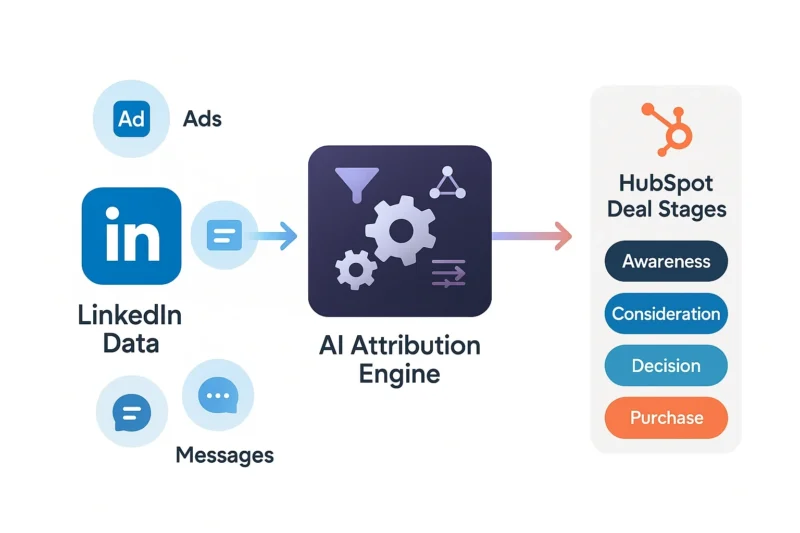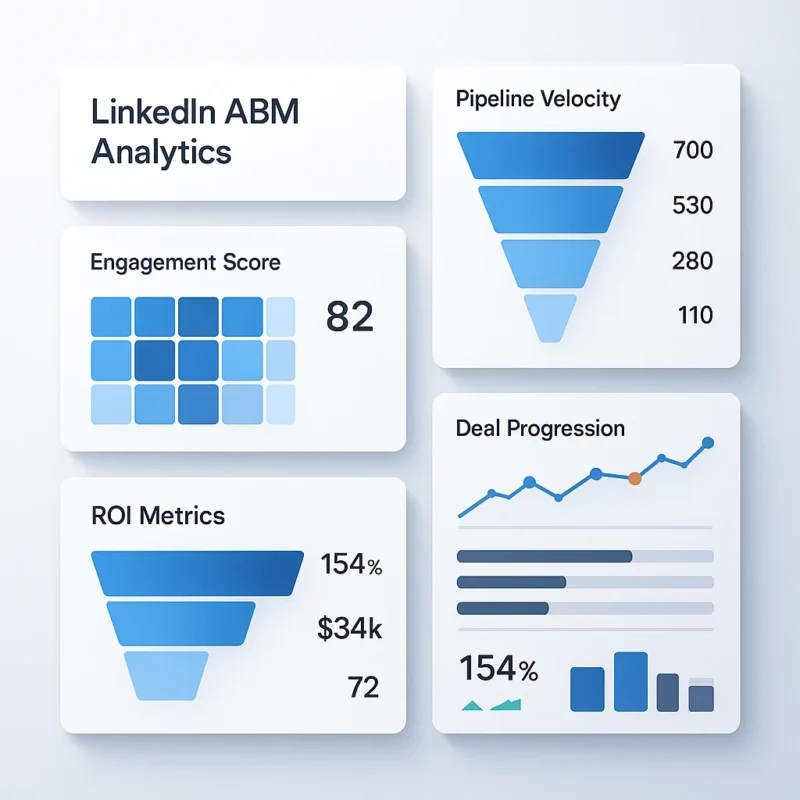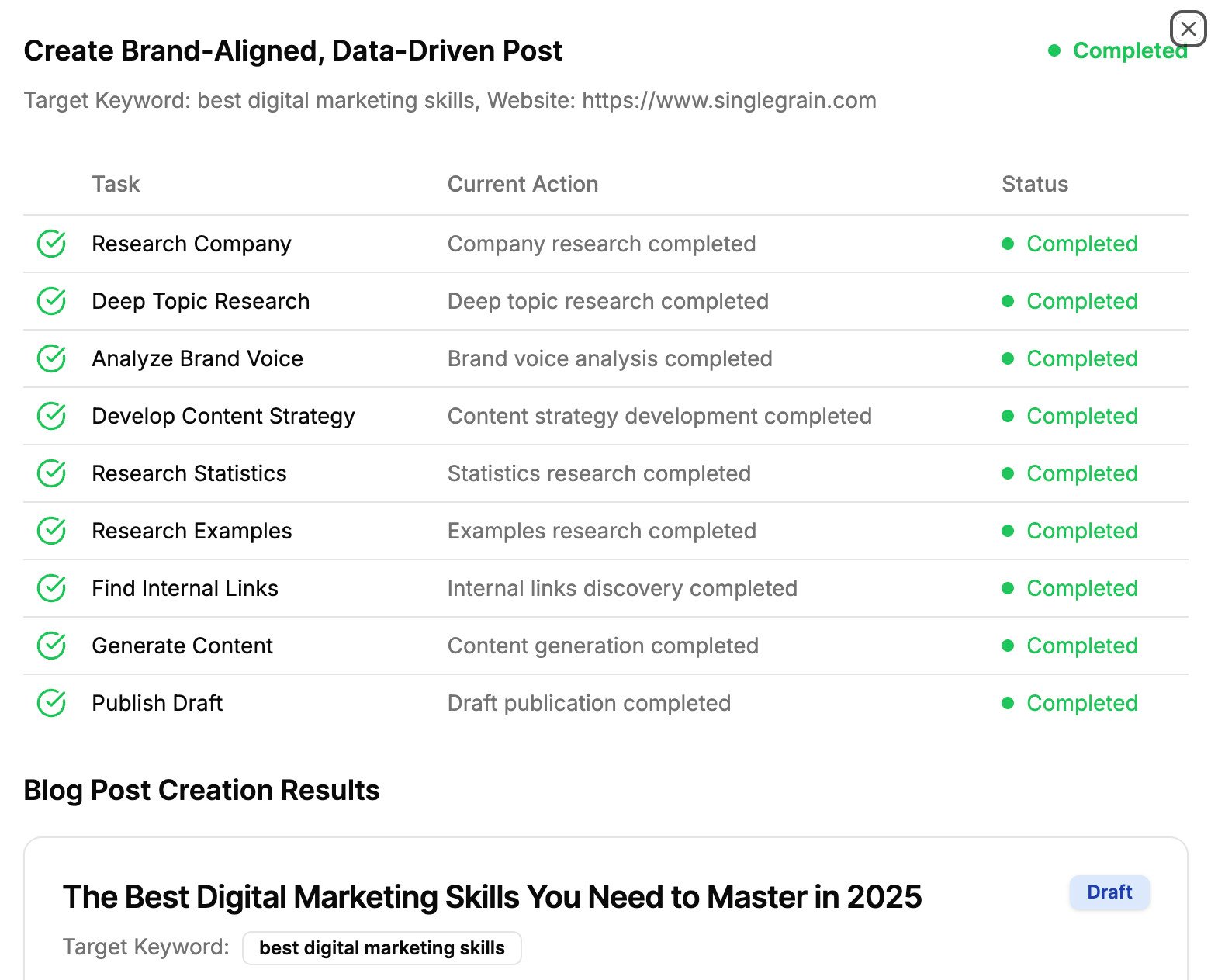When BioCatch needed to grow their pipeline value by 5× within six months without expanding their target account list, they turned to an AI-orchestrated ABM program that synchronized LinkedIn Campaign Manager with HubSpot’s intelligent deal stage tracking. The result? Every LinkedIn interaction, from ad impressions to SDR calls, was captured, attributed, and used to accelerate deal progression through precisely defined stages.
For B2B teams managing complex sales cycles, tracking how LinkedIn ABM activities influence deal progression has become essential for proving ROI and optimizing spend allocation. With 87% of ABM-focused HubSpot users having adopted LinkedIn integrations by early 2025, the foundation for AI-driven deal stage tracking is already in place for most organizations.
Key Takeaways
- Establish seamless LinkedIn-HubSpot integration using no-code platforms like ZenABM to sync all LinkedIn touchpoints (ad clicks, engagement, messages) directly into HubSpot custom properties for comprehensive deal stage visibility
- Create ABM-specific deal stages that reflect account-based buying journeys, including “Account Identified,” “Stakeholder Mapping,” and “Committee Evaluation” stages with AI-powered scoring criteria for automatic progression
- Implement position-based attribution models that assign higher weights to LinkedIn activities at critical decision points, enabling HubSpot AI to predict deal stage progression and prioritize sales outreach timing
- Track LinkedIn ABM deal stages with HubSpot AI to achieve measurable results like BioCatch’s 5× pipeline growth and MobyCap’s 1,733% conversion lift through automated stage transitions and predictive analytics
- Build executive dashboards focused on business outcomes rather than marketing metrics, highlighting how LinkedIn ABM activities contribute to pipeline velocity, win rates, and revenue with year-over-year performance comparisons
TABLE OF CONTENTS:
Building Your LinkedIn-HubSpot Integration Foundation
The cornerstone of effective ABM deal stage tracking lies in establishing seamless data flow between LinkedIn Campaign Manager and HubSpot’s CRM. This integration creates the data foundation that enables AI-powered attribution and automated deal stage progression based on engagement signals.
Modern integration platforms eliminate the technical complexity that previously required developer resources. Tools like ZenABM and Linked Helper provide no-code solutions that sync LinkedIn lead data, engagement history, and campaign performance directly into HubSpot custom properties. This two-way data synchronization ensures that every LinkedIn touchpoint, whether organic engagement or paid advertising interaction, contributes to your deal stage visibility.

The key to successful integration lies in mapping LinkedIn engagement activities to specific HubSpot properties that trigger deal stage transitions. For instance, when a target account clicks a LinkedIn ad, views your company page, or engages with sponsored content, these actions should automatically update custom fields that feed into HubSpot’s AI scoring algorithms.
Configuring HubSpot Deal Stages for ABM Success
Traditional deal stages often fail to capture the nuanced journey of ABM prospects, who may engage across multiple touchpoints before entering the formal sales process. Successful ABM programs require customized deal stages that reflect the account-based buying journey and enable precise attribution of LinkedIn activities.
Start by creating ABM-specific deal stages that acknowledge the extended awareness and consideration phases typical in account-based sales. These might include “Account Identified,” “Initial Engagement,” “Stakeholder Mapping,” “Committee Evaluation,” and “Executive Approval” before reaching traditional stages like “Proposal” and “Closed Won.”
“Pipeline velocity, how quickly deals move from stage to stage, more than triples when LinkedIn engagement data is synced to HubSpot for ABM targeting and measurement. Ad-influenced accounts progress through the sales pipeline 234% faster than non-ad-influenced accounts when LinkedIn and HubSpot are used together in an ABM motion.” – RollWorks Data Team
Each custom deal stage should have associated criteria that can be automatically evaluated using HubSpot’s AI capabilities. For example, the transition from “Initial Engagement” to “Stakeholder Mapping” might require a combination of LinkedIn ad clicks, website visits, and content downloads from multiple contacts within the target account.
| Deal Stage | LinkedIn Trigger Activities | HubSpot AI Scoring Weight | Typical Duration |
|---|---|---|---|
| Account Identified | Company page visit, ad impression | 10-25 points | 0-30 days |
| Initial Engagement | Ad click, content download, message open | 25-50 points | 15-45 days |
| Stakeholder Mapping | Multiple contact engagement, event attendance | 50-75 points | 30-90 days |
| Committee Evaluation | Demo request, pricing page visit, competitor comparison | 75-90 points | 45-120 days |
| Executive Approval | Executive engagement, budget-related inquiries | 90-100 points | 30-60 days |
Implementing AI-Powered Attribution Models
HubSpot’s AI attribution capabilities shine when properly configured to analyze LinkedIn ABM touchpoints across extended sales cycles. The platform’s machine learning algorithms can identify patterns in engagement sequences that predict deal stage progression, enabling automated scoring and stage transitions based on behavioral signals.
Position-based attribution models work particularly well for ABM scenarios because they appropriately weight both initial awareness-building activities and final conversion events. Configure your attribution model to assign higher weights to LinkedIn activities that occur at critical decision points, such as executive-level engagement or competitor comparison research.
The AI-driven approach becomes particularly powerful when you layer intent scoring on top of traditional engagement metrics. HubSpot can analyze the timing, frequency, and depth of LinkedIn interactions to predict which accounts are most likely to progress to the next deal stage. This predictive capability enables sales teams to prioritize outreach and allocate resources more effectively.
Real-World Implementation Success Stories
The fintech company BioCatch demonstrates how precise LinkedIn-HubSpot integration can multiply pipeline value without expanding target account lists. Facing the challenge of growing pipeline velocity within a fixed universe of financial services accounts, BioCatch deployed an AI-orchestrated ABM program that achieved remarkable results.
Their solution centered on HubSpot’s AI-based intent scoring system, which automatically decided when accounts progressed from ‘Engaged’ to ‘Sales Accepted’ to ‘Opportunity’ stages. Automated workflows surfaced real-time stage changes to SDRs, enabling perfectly-timed outreach when prospects showed the strongest buying signals. Every LinkedIn ad click, impression, and subsequent SDR interaction was written back to custom deal properties, creating comprehensive stage-by-stage attribution reporting.
The results spoke volumes: a 5× increase in total pipeline value within just six months, achieved without adding new accounts and with markedly faster progression through early- and mid-funnel deal stages. This success illustrates how AI-driven orchestration between LinkedIn and HubSpot can multiply pipeline effectiveness when every deal-stage transition is tracked and acted upon in real time.
Similarly, MobyCap, a specialty lender, needed to boost conversions from LinkedIn ABM campaigns while reducing acquisition costs. They built AI-powered dynamic retargeting sequences on LinkedIn, using HubSpot as the orchestration and analytics hub. Intent signals from LinkedIn automatically updated deal properties, triggered stage-specific nurture emails, and fed HubSpot AI models that predicted likelihood-to-close.
This integrated approach enabled precise budget reallocation toward late-stage opportunities, resulting in a 1,733% lift in total conversions, 264% higher conversion rate, and an 82% drop in cost per conversion. The success was directly attributed to faster movement from ‘Discovery’ to ‘Negotiation’ stages, powered by AI-driven insights into optimal engagement timing and messaging.
Building High-Impact ABM Dashboards
Effective deal stage tracking requires dashboards that provide both granular insights and executive-level summaries. HubSpot’s reporting capabilities, when properly configured for ABM, can create compelling narratives about how LinkedIn activities drive pipeline progression and revenue outcomes.
Start with a deal velocity dashboard that shows average time spent in each stage, broken down by LinkedIn engagement levels. Accounts with high LinkedIn engagement should demonstrate shorter cycle times and higher progression rates. This visualization makes the case for continued ABM investment and helps identify bottlenecks in your sales process.

Create attribution reports that connect specific LinkedIn campaigns to deal stage movements. These reports should show which ad creative, targeting parameters, and engagement types most effectively move accounts from one stage to the next. This granular attribution enables optimization of both creative assets and audience targeting for maximum stage progression impact.
Executive dashboards should focus on business outcomes rather than marketing metrics. Highlight how LinkedIn ABM activities contribute to pipeline value, deal velocity, and win rates. Include year-over-year comparisons and benchmark data to demonstrate continuous improvement and ROI justification.
Optimizing Win Rates Through AI-Enhanced ABM
The ultimate measure of successful LinkedIn ABM deal stage tracking lies in improved conversion rates and revenue outcomes. Research shows that B2B ABM programs that integrate LinkedIn with HubSpot achieve a 38% higher sales win rate than traditional approaches. This improvement stems from the enhanced visibility and timing that AI-powered deal stage tracking provides.
HubSpot’s AI can identify the optimal timing for sales outreach based on LinkedIn engagement patterns. When prospects demonstrate specific engagement behaviors, such as visiting pricing pages after clicking LinkedIn ads or engaging with multiple pieces of content within a short timeframe, the system can trigger automated alerts for immediate sales follow-up.
The key to maximizing win rates lies in personalizing outreach based on the specific LinkedIn touchpoints that drove stage progression. Sales teams armed with detailed engagement history can craft messages that reference specific content pieces, events, or campaigns that prospects found valuable, creating more relevant and compelling conversations.
Advanced implementations use HubSpot’s predictive analytics to identify which accounts are most likely to close based on their LinkedIn engagement patterns. This predictive capability enables sales teams to prioritize their efforts on accounts with the highest probability of success, improving overall team efficiency and win rates.
For organizations seeking to implement or optimize their LinkedIn ABM deal stage tracking, consider conducting a comprehensive audit of your current setup. Professional assessment can identify gaps in integration, attribution modeling, and reporting that may be limiting your pipeline growth potential. Get a Free Audit to evaluate your current ABM tracking capabilities and identify opportunities for improvement.
Scaling Your ABM Tracking for Sustainable Growth
Successfully tracking LinkedIn ABM deal stages with HubSpot AI requires more than initial setup. It demands ongoing optimization and scaling strategies that evolve with your business growth. As your target account list expands and your sales processes mature, your tracking mechanisms must adapt to maintain accuracy and actionable insights.
The most successful implementations establish clear feedback loops between sales teams and marketing operations. Regular reviews of deal stage progression data should inform both LinkedIn campaign optimization and HubSpot configuration adjustments. This iterative approach ensures that your tracking system continues to provide predictive value as market conditions and buyer behaviors evolve.
Consider implementing advanced segmentation strategies that account for different buyer personas, industry verticals, and deal sizes. Each segment may exhibit different progression patterns through your deal stages, requiring customized scoring algorithms and attribution models. HubSpot’s AI capabilities can manage this complexity when properly configured with sufficient historical data and clear success criteria.
The integration of LinkedIn ABM tracking with HubSpot AI represents a fundamental shift toward data-driven B2B sales acceleration. Organizations that master this integration, combining precise attribution, predictive analytics, and automated optimization, position themselves to achieve the kind of transformative growth that industry leaders like BioCatch and MobyCap have demonstrated. The key lies not just in implementing the technology, but in creating organizational processes that turn AI insights into consistent revenue outcomes.
Ready to finally prove that your LinkedIn ABM spend is actually driving deals forward?
Frequently Asked Questions
-
What no-code platforms can help integrate LinkedIn Campaign Manager with HubSpot?
Tools like ZenABM and Linked Helper provide no-code solutions that sync LinkedIn lead data, engagement history, and campaign performance directly into HubSpot custom properties. These platforms eliminate the technical complexity that previously required developer resources for integration.
-
What custom deal stages should I create for ABM in HubSpot?
Create ABM-specific stages like “Account Identified,” “Initial Engagement,” “Stakeholder Mapping,” “Committee Evaluation,” and “Executive Approval” before traditional stages. Each stage should have associated criteria that can be automatically evaluated using HubSpot’s AI capabilities based on LinkedIn engagement activities.
-
How do position-based attribution models work for LinkedIn ABM campaigns?
Position-based attribution models assign higher weights to LinkedIn activities that occur at critical decision points, such as executive-level engagement or competitor comparison research. This approach appropriately weights both initial awareness-building activities and final conversion events in extended ABM sales cycles.
-
What LinkedIn activities should trigger automatic deal stage progression?
Key triggers include ad clicks, content downloads, company page visits, multiple contact engagement, demo requests, and executive-level interactions. HubSpot’s AI can analyze the timing, frequency, and depth of these LinkedIn interactions to predict which accounts are most likely to progress to the next deal stage.
-
What metrics should I include in executive ABM dashboards?
Focus on business outcomes rather than marketing metrics, highlighting how LinkedIn ABM activities contribute to pipeline value, deal velocity, and win rates. Include year-over-year comparisons and benchmark data to demonstrate continuous improvement and ROI justification.
-
How much can LinkedIn ABM integration with HubSpot improve win rates?
B2B ABM programs that integrate LinkedIn with HubSpot achieve a 38% higher sales win rate than traditional approaches. This improvement stems from enhanced visibility, optimal timing for outreach, and the ability to personalize messages based on specific LinkedIn engagement patterns.
-
How do I scale my LinkedIn ABM tracking system as my business grows?
Establish clear feedback loops between sales teams and marketing operations with regular reviews of deal stage progression data. Implement advanced segmentation strategies for different buyer personas, industry verticals, and deal sizes, as each segment may exhibit different progression patterns requiring customized scoring algorithms.





